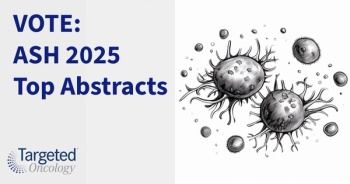
Adagrasib With/Without Cetuximab Generates Responses in Advanced KRAS G12C–Mutated CRC
The use of adagrasib in combination with cetuximab or alone elicted encouraging responses in patients with advanced colorectal cancer harboring KRAS G12C mutations.
Data from the phase 1b/2 KRYSTAL-1 trial (NCT03785249) showed that adagrasib (MRTX849) monotherapy and in combination with cetuximab (Erbitux) showed encouraging responses in patients with advanced colorectal cancer (CRC) harboring KRAS G12C mutations, according to findings presented at the 2022 ESMO Congress.
The combination of adagrasib and cetuximab was evaluated in the phase 1b portion of the trial, and at a median follow-up of 17.5 months, evaluable patients (n = 28) experienced an objective response rate (ORR) of 46%, with a disease control rate of 100%. All 13 responders had a partial response (PR), and 15 patients had stable disease.
The median duration of response (DOR) with the combination was 7.6 months, and the median time to response (TTR) was 1.4 months. The median progression-free survival was 6.9 months (95% CI, 5.4-8.1), and the 6- and 12-month PFS rates were 60% and 24%, respectively. The median OS was 13.4 months (95% CI, 9.5-20.1), with 6- and 12-month overall survival (OS) rates of 84% and 61%, respectively.
At a median follow-up of 20.1 months in the phase 2 portion of the trial evaluating single-agent adagrasib, evaluable patients (n = 43) achieved an ORR of 19% and a disease control rate of 86%. All 8 responders experienced a PR, 29 patients had stable disease, and 6 patients experienced disease progression.
Single-agent adagrasib resulted in a median DOR of 4.3 months, with a median TTR of 1.5 months. Patients achieved a median PFS of 5.6 months (95% CI, 4.1-8.3), with 6- and 12-month PFS rates of 47% and 15%, respectively. The median OS was 19.8 months (95% CI, 12.5-23.0), with 6- and 12-month OS rates of 93% and 69%, respectively.
“Consistent with preclinical hypothesis, the combination [of adagrasib and cetuximab] resulted in a numerically higher response rate and longer median PFS than the monotherapy cohort,” Samuel Klempner, MD, a medical oncologist at Massachusetts General Hospital, said in a presentation of the data.
KRAS G12C mutations occur in approximately 3% to 4% of patients with CRC, and they serve as a negative predictor of efficacy with cetuximab. The presence of these mutations is also linked with poor prognosis vs other KRAS mutations, and limited treatment options are available in later lines of therapy for patients with CRC.
KRYSTAL-1 evaluated the efficacy of the KRAS G12C inhibitor adagrasib both as a single agent and in combination with cetuximab. The trial enrolled patients with unresectable or metastatic CRC harboring a KRAS G12C mutation. Patients were required to have received prior systemic treatment for metastatic disease. They could not have had any available treatment with curative intent or available standard of care.
In the phase 1b portion of the trial, patients received 600 mg of oral adagrasib twice daily plus cetuximab at 400 mg/m2 followed by 250 mg/m2 every week or 500 mg/m2 every 2 weeks. In the phase 2 portion, patients were administered 600 mg of oral adagrasib twice daily.
The primary end points in phase 1b comprised safety, identifying the recommended phase 2 dose, and pharmacokinetics. Secondary end points included ORR per RECIST v1.1 criteria, DOR, PFS, and OS. The primary end point of the phase 2 portion of the research was ORR, with secondary end points of DOR, PFS, OS, and safety.
Klempner noted that baseline patient characteristics in both cohorts were consistent with a heavily pretreated CRC population. The median age in the monotherapy and combination groups was 59 years (range, 29-79) and 60 years (range, 41-74), respectively. In the monotherapy cohort, 52% of patients had an ECOG performance status of 0 and 48% had a status of 1; in the combination cohort, these rates were 44% and 56%, respectively.
The median prior lines of systemic therapy received in both cohorts was 3 (range, 1-9). In the monotherapy cohort, 18% of patients received 1 prior line, 21% received 2, 25% received 3, and 36% received 4 or more; those rates were 9%, 25%, 34%, and 31%, respectively, in the combination cohort.
Prior treatment in the monotherapy cohort included fluoropyrimidine (100%), oxaliplatin (98%), irinotecan (80%), anti-VEGF therapy (82%), anti-EGFR biological therapy (2%), and regorafenib (Stivarga) and/or trifluridine/tipiracil (Lonsurf; 23%). In the combination cohort, all patients had previously received fluoropyrimidine and oxaliplatin, 88% received prior irinotecan, 88% had a prior anti-VEGF therapy, and 19% had received prior regorafenib and/or trifluridine/tipiracil.
Regarding safety in the adagrasib/cetuximab cohort, all patients experienced at least 1 any-grade treatment-related adverse effect (TRAE). Nine percent of patients had a grade 3 TRAE, and 2 patients had a grade 4 TRAE; the grade 4 effects were an infusion-related reaction associated with cetuximab, and hyperkalemia. No grade 5 TRAEs were reported.
The most common any-grade TRAEs included nausea (63%), diarrhea (56%), vomiting (53%), dermatitis acneiform (47%), fatigue (47%), dry skin (41%), headache (31%), dizziness (25%), maculopapular rash (25%) and stomatitis (22%). Grade 3 TRAEs included diarrhea (3%), dermatitis acneiform (3%), and stomatitis (3%).
TRAEs led to the discontinuation of cetuximab in 16% of patients, although no patients discontinued adagrasib due to TRAES. Additionally, TRAEs led to adagrasib dose reductions and interruptions in 31% and 44% of patients, respectively.
In the adagrasib-monotherapy cohort, any-grade TRAEs were reported in 93% of patients, and 30% experienced grade 3 TRAEs. Two patients had grade 4 TRAES in the form of pericardial effusion and decreased neutrophil count. No grade 5 TRAEs occurred.
The most common any-grade TRAEs included diarrhea (66%), nausea (57%), fatigue (46%), vomiting (46%), decreased appetite (18%), anemia (16%), QT prolongation (16%), and peripheral edema (16%). Grade 3 TRAEs included diarrhea (7%), fatigue (5%), anemia (9%), and QT prolongation (5%).
In the monotherapy cohort, no TRAEs resulted in treatment discontinuation. Dose reductions and interruptions were required in 39% and 46% of patients, respectively.
The combination of adagrasib and cetuximab will be further evaluated in the second-line setting as part of the phase 3 KRYSTAL-10 trial (NCT04793958) trial, and in the late-line setting as part of KRYSTAL-1 in a potentially registration-enabling phase 2 cohort.
KRYSTAL-10 will enroll patients with KRAS G12C–mutated metastatic CRC who experienced progression on a first-line fluoropyrimidine-based, oxaliplatin or irinotecan regimen. Patients will be randomly assigned to received 600 mg of oral adagrasib twice daily plus 500 mg/m2 of cetuximab every 2 weeks in the experimental arm, or FOLFIRI or mFOLFOX6 in the control arm. The primary end points of the trial are PFS and OS, and secondary end points include ORR, 1-year OS, DOR, pharmacokinetics, patient-reported outcomes, and safety.
“This trial is open and accruing in the United States, Asia, and Europe,” Klempner concluded.









































